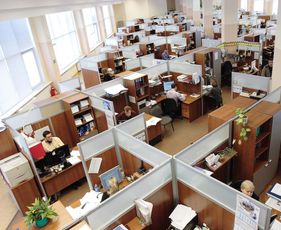This list reveals the most deadly industries in the UK, with the total number of fatalities recorded amongst workers and members of the public between 2014 and 2022. Top of the list for combined fatalities is the public administration and defence industry, although the construction industry has the highest number of worker-related deaths recorded within the eight year time span reviewed here.
Jonathan Merry, CEO of Moneyzine, comments:
“A number of things may impact what career path a person chooses to take - average salary, qualifications, etc - but is an individual’s safety something they should consider, too? This list highlights the sectors in which the most accidents can occur, shedding some light on the most dangerous careers for people in the UK to embark on.”
What is the most common cause of death for workers?
The main kinds of fatal accidents for workers in 2021/22 were falls from a height, being struck by a moving vehicle, or being struck by a moving object, as reported by HSE. This data correlates with the most common types of accident reported in the 2017/18 report, suggesting that while the rate of injury has fallen in recent years, the biggest hazards and risks for workers remain the same.
Rate of injury
The rate of injury is an important consideration when looking at the most deadliest industries, because it takes into account the differences in size of the workforce. The rate divides the count of injuries by the employment estimate - demonstrating, for example, that the rate of injury can be considered highest amongst agriculture, forestry, and fishing, but comparatively very low in the arts and entertainment industry.
10 Deadliest Industries in the UK (By Total Recorded Fatalities Between 2014 and 2022)
1. Public Administration and Defence
This sector comprises the organisations responsible for government activities such as maintaining public safety and order, implementing laws and policies, immigration services, national defence, and civil and criminal law courts. According to HSE, this sector accounts for 7% of the workforce in the UK.
In the eight year timespan between 2014 and 2022, there were a reported 430 fatal deaths in total - 171 workers were fatally injured, while 259 members of the public were fatally injured in this period. Across the timespan, the average rate of injury per 100,000 workers was just 0.05, reflecting the size of this industry.
Industry | Fatal injuries to members of the public (2014-2022) | Fatal injuries to workers (2014-2022) | Total fatal injuries |
Public administration and defence; compulsory social security; education; human health and social work activities | 259 | 171 | 430 |
2. Transportation and storage
The transportation and storage industry here does not represent injuries arising on railways or offshore from 2021/13 onwards, which account for approximately 1,125 non-fatal injuries per year). In eight years, there have been a total of 415 fatal injuries in this industry - with 302 members of the public fatally injured, and 113 workers.
This industry is still considered relatively small in the UK, accounting for 5% of business premises. The overall average rate of injury per 100,000 workers in this time period amounts to 0.92.
Industry | Fatal injuries to members of the public (2014-2022) | Fatal injuries to workers (2014-2022) | Total fatal injuries |
Transportation and storage | 302 | 113 | 415 |
3. Construction
It’s important to note that while the construction industry has the third highest rate of mortality between 2014 and 2022, it actually had the highest number of worker deaths overall, at 293 workers fatally injured in this eight year period.
The construction industry accounts for approximately 3 million jobs and 10% of total UK employment, taking the average rate of injury per 100,000 workers to 1.67.
Industry | Fatal injuries to members of the public (2014-2022) | Fatal injuries to workers (2014-2022) | Total fatal injuries |
Construction | 35 | 293 | 328 |
4. Agriculture, forestry, and fishing
The agriculture, forestry, and fishing industry has the fourth overall highest fatality rate, but the second highest number of deaths recorded amongst workers overall. What’s more, this industry has the highest average rate of injury per 100,000 workers in the eight year time span reviewed, at 8.39.
According to HSE, the most common cause of death within this industry was overturning vehicles or being struck by moving vehicles, with more than a third of workers killed between 2021/22 aged 65 or over.
Industry | Fatal injuries to members of the public (2014-2022) | Fatal injuries to workers (2014-2022) | Total fatal injuries |
Agriculture, forestry and fishing | 32 | 223 | 255 |
5. Human health and social work activities
The fifth most deadly industry in the UK is human health and social work activities, although it’s important to note that just 8 deaths have been recorded amongst workers between 2014 and 2022, with members of the public accounting for the remaining 205 fatalities.
The majority of these deaths are to patients and service users, and are therefore less likely to be deemed as accidents and more as natural causes of death. This industry has a rate of injury per 100,000 workers of just 0.04.
Industry | Fatal injuries to members of the public (2014-2022) | Fatal injuries to workers (2014-2022) | Total fatal injuries |
Human health and social work activities | 205 | 8 | 213 |
6. Manufacturing
Manufacturing is another industry with a high number of fatalities to workers - 159 between 2014 and 2022, whilst just 2 deaths of members of the public were recorded in the same time period.
The rate of injury per 100,000 workers in manufacturing is 0.7. The UK is currently the ninth largest manufacturing country in the world, with an estimated annual output of £183 billion.
Industry | Fatal injuries to members of the public (2014-2022) | Fatal injuries to workers (2014-2022) | Total fatal injuries |
Manufacturing | 2 | 159 | 161 |
7. Wholesale and retail trade
The wholesale and retail trade sector includes the repair of motor vehicles, accommodation and food service activities. In total, 141 fatalities were recorded within this sector in the past eight years, with 82 worker-related fatalities and 59 deaths in members of the public.
The overall rate of injury per 100,000 workers for the wholesale and retail trade sector is 0.18.
Industry | Fatal injuries to members of the public (2014-2022) | Fatal injuries to workers (2014-2022) | Total fatal injuries |
Wholesale and retail trade | 59 | 82 | 141 |
8. Information and communication
The UK is considered one of the world’s largest information and communications industries, and encompasses financial and insurance activities, real estate activities, scientific and technical activities, and support service activities.
A total of 112 deaths have been recorded in both workers and members of the public in this industry between 2014 and 2022, with 86 deaths recorded amongst workers and 26 fatalities to members of the public. The average rate of injury per 100,000 workers in this eight year time span is 0.15 for the information and communication industry.
Industry | Fatal injuries to members of the public (2014-2022) | Fatal injuries to workers (2014-2022) | Total fatal injuries |
Information and communication | 26 | 86 | 112 |
9. Arts, entertainment, and recreation
The arts, entertainment, and recreation industry is the ninth most deadly industry in the UK, with a total of 84 fatalities between 2014 and 2022 and an average rate of injury of 0.15.
This industry sector encompasses activities or households as employers, undifferentiated services producing activities for their own uses, and the activities of extraterritorial organisation. In total, 21 deaths amongst workers were recorded in this eight year time span, while 63 deaths were recorded amongst members of the public.
Industry | Fatal injuries to members of the public (2014-2022) | Fatal injuries to workers (2014-2022) | Total fatal injuries |
Arts, entertainment and recreation | 63 | 21 | 84 |
10. Water supply
Finally, the tenth deadliest industry in the UK is the water supply industry, including sewerage, waste management, and remediation activities. A total of 81 deaths were recorded between 2014 and 2022.
The majority of deaths in this industry were to workers, with 61 worker-related fatalities reported, and a further 20 deaths to members of the public. This industry actually has a considerably higher average rate of injury per 100,000 workers than a number of industries featured on this list (higher than arts and entertainment, information and communication, and wholesale and retail trade, for example), with a rate of 3.35.
Industry | Fatal injuries to members of the public (2014-2022) | Fatal injuries to workers (2014-2022) | Total fatal injuries |
Water supply | 20 | 61 | 81 |
Fatal Injuries to Members of the Public and Workers Between 2014 and 2022 by Industry
Industry | Fatal injuries to members of the public (2014-2022) | Fatal injuries to workers (2014-2022) | Total Fatalities Recorded |
Public administration and defence | 259 | 171 | 430 |
Transportation and storage | 302 | 113 | 415 |
Construction | 35 | 293 | 328 |
Agriculture, forestry and fishing | 32 | 223 | 255 |
Human health and social work activities | 205 | 8 | 213 |
Manufacturing | 2 | 159 | 161 |
Wholesale and retail trade | 59 | 82 | 141 |
Information and communication | 26 | 86 | 112 |
Arts, entertainment and recreation | 63 | 21 | 84 |
Water supply | 20 | 61 | 81 |
Methodology
These figures were sourced from a raw data set provided by HSE. The original data consisted of individual data sets for each year from 2014/15 up until 2021/22. Our experts calculated the overall number of fatalities for workers and members of the public within this time span.
Contributors





